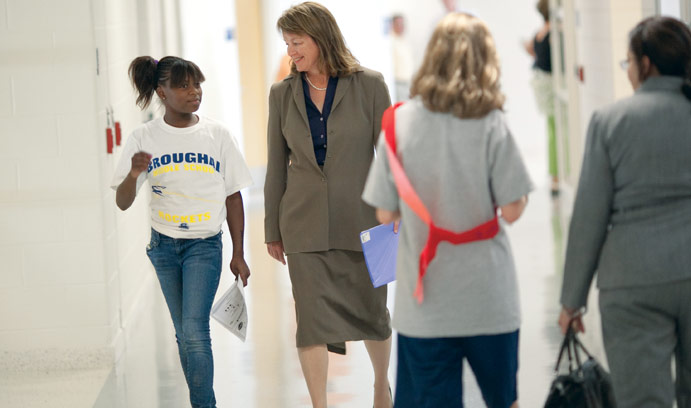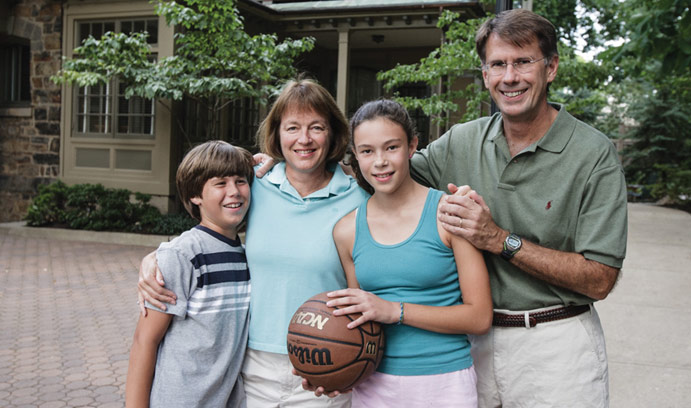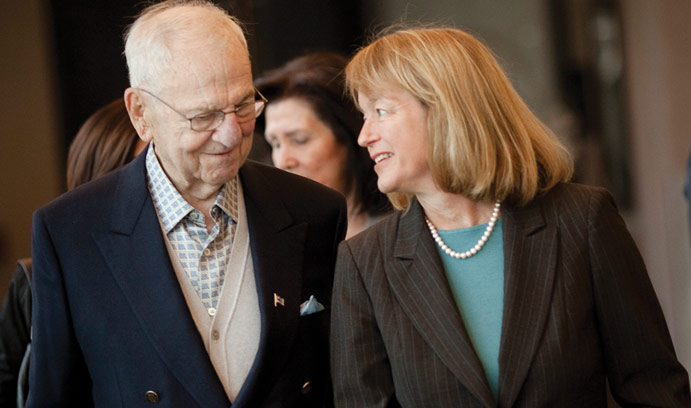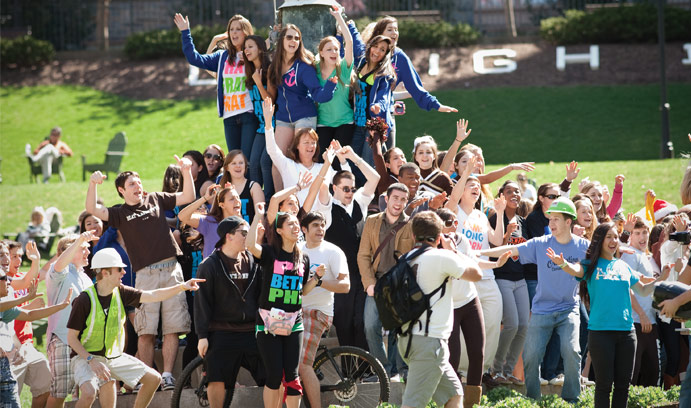A Transformative Presidency
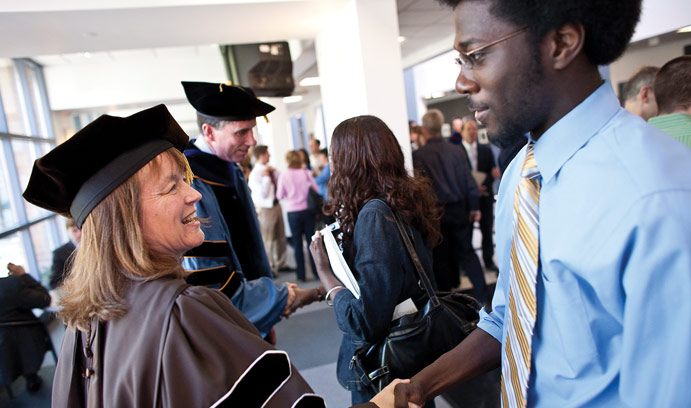
President Alice P. Gast pushed the university forward in four key areas: the student experience, academic excellence, the university’s global impact and Lehigh’s willingness to take on the biggest challenges of the day.
“Let us set our sights high.” That was the challenge laid out by Alice P. Gast upon her inauguration as Lehigh’s 13th president on April 13, 2007.
Eight years later, as Gast’s final semester at Lehigh comes to a close and she transitions into her new role as president of Imperial College London, it is clear that Lehigh under her leadership accepted her challenge—and is, as a result, a better place for it.
The evidence of this can be found everywhere. It can be found in the heart of campus, where the STEPS building stands as a testament to Gast’s commitment to sustainability, and it can be found atop South Mountain, where the groundbreaking Mountaintop project is redefining higher education in the 21st century. It can be found in communities across America, where students have completed scores of important service projects, and in developing nations across the world, where they are undertaking sustainability and entrepreneurship initiatives to enact real change. It can be found in Upper Saucon Township, where a vast new tract of land offers enormous possibilities for Lehigh’s future, and in South Bethlehem, where stronger bonds between the university and its community are making a measurable change in the lives of residents. It can be found in the historic financial strength of the University, and it can be found in the enduring commitment of Lehigh alumni to their alma mater.
Mostly, though, it can be found in the inquisitive, entrepreneurial, committed individuals who make up Lehigh’s campus community—the students, faculty, staff and alumni who accepted the challenge Gast issued eight years ago, and who have over the course of those eight years pushed this university forward in their own unique way.
In commemoration of a Lehigh tenure replete with accomplishments, the Lehigh Bulletin has compiled a retrospective of Gast’s eight years in office. It looks at how she pushed the university forward in four key areas—the student experience, academic excellence, the university’s global impact and Lehigh’s willingness to take on the biggest challenges of the day—and also makes clear the enormous impact Gast has had not only in creating the Lehigh of today, but in influencing where this university will be five, 10 or even 20 years into the future.
The Student Experience
STUDENTS FIRST In an August 27, 2006, Convocation speech that served as her first major address to the campus community and established what would be an enduring commitment to the student experience, President Gast spoke to students about the responsibilities that come along with freedom, the importance of chasing their dreams, and the deep value of the relationships that they would make during their years at Lehigh. She also promised to make the student experience a top priority during her presidency. “One of the things that drew me to Lehigh was the university’s clear and unwavering focus on students. At Lehigh, our loyal alumni, outstanding faculty and dedicated administrators are all equally and wholeheartedly committed to undergraduate excellence. We are dedicated to making your years here at Lehigh as productive, rich and valuable as possible. We are here because of you and for you.”
A CLEAR GOAL When Lehigh under President Gast’s leadership embarked on an ambitious, 10-year master campus planning process in 2009, the ultimate aim was to create the kind of campus spaces that maximize learning opportunities for its students. “Our plan clearly articulates a goal of creating an environment where the academic and living experiences merge into an integrated learning experience,” President Gast said at the time. “As we seek to engage every student in the full breadth of opportunity available at Lehigh, we can use this opportunity to take a critical look at how our spaces can draw our community together in creative and productive ways.”
CHANGING THE CULTURE The first year of Lehigh After Dark concluded, and by all accounts, it was a massive success, offering students 45 new social opportunities to pursue on weekend nights. The program has become an important part of Lehigh’s efforts under President Gast to deemphasize drinking on campus.
NEW EXPERIENCE Lehigh in 2012 launched the LehighSiliconValley program, a one-week immersion workshop for Lehigh students near San Francisco, California. The unique program is coordinated by the Baker Institute for Entrepreneurship, Creativity and Innovation and has quickly become a signature program for the Institute. Said Tyler Walton ’12, a participant in the program’s first year: “You gain more practical experience in one week than you do in a semester of lectures. The people we read about in normal case studies are suddenly in front of us, and we were in a position to ask them whatever we wanted.”
STEM SUCCESS In recognition of the 40th anniversary of undergraduate women at Lehigh, President Gast announced in 2012 the establishment of a new $1 million endowed scholarship program to support women studying in the science, technology, engineering and mathematics (STEM) fields. The announcement was one of the highlights of the yearlong 40 Years of Women celebration at Lehigh.
A WIN FOR THE AGES In one of the most memorable moments in Lehigh sports history, the men’s basketball team, led by star shooting guard CJ McCollum, upset the mighty Duke Blue Devils, 75-70, in the second round of the 2012 NCAA men’s basketball tournament. The victory sparked celebrations all around campus and put Lehigh’s true scholar-athlete athletics model on the national stage. Wrote President Gast in an op-ed that appeared in the Allentown Morning Call afterward: “We admire them for the way they believed in themselves. Their incredible prowess on the court was only outdone by their intelligence and demeanor in front of the cameras. The rigorous education they receive at Lehigh and their demanding training were evident in their confidence and poise. We take their example as a reminder to all of us: Commit yourself to excellence, work hard, and believe in yourself.”
UP ON THE MOUNTAIN In what might prove to be her lasting legacy at Lehigh, President Gast in October of 2013 announced that Lehigh had received a $20 million gift from alumnus Scott Belair ’69 to formally create the “Mountaintop Experience”—the reimagining of 120,000 square feet of former Bethlehem Steel research facilities into spaces for innovative and open-ended learning experiences for Lehigh students. Calling the gift a “defining moment” for Lehigh, Gast praised Belair’s generosity and laid out a bold vision for what the space might eventually become. “Great spaces can serve as catalysts for progress,” she said. “There are rare moments in the history of a university when an absolutely unique opportunity arises. This is one of those moments.” The project launch drew plaudits from media nationwide and brought newfound attention to Lehigh. Wrote Fast Company magazine: “In an age where Massive Open Online Courses, or MOOCs, challenge traditional higher educational hierarchies by providing anyone coursework on a screen, the Mountaintop project is taking physical, collaborative learning environments and hurtling them into the 21st century.” This past spring, Lehigh announced that 27 more projects would take place at Mountaintop during the summer of 2014.
REAL RESULTS A university’s greatest obligation is to prepare students to succeed in the real world, and in that regard, Lehigh under President Gast is excelling. According to a 2013 report, of Lehigh’s 1,020 bachelor degree recipients, verifiable post-graduation career activities were obtained for 88 percent of the graduates. This data was acquired directly from graduates, employers, university staff members, parents and LinkedIn profiles. The percentage, or knowledge rate, of similar data collected by other universities nationwide is 60 to 65 percent.
Lehigh Goes Global
SETTING THE STAGE In 2007, just after her arrival on campus, President Gast developed her strategy for “Getting to Global Lehigh,” with the aim of creating a true global culture on campus. “We want internationalism to flow not only from formal instruction but also from day-to-day conversations, associations and friendships,” she said of the initiative. “This includes providing meaningful international experiences for our students and welcoming more international students and visitors to our university.” In the years since, Lehigh has offered an ever-expanding array of programs to allow students to study, work and conduct research abroad.
A QUANTUM LEAP In July of 2011, Lee Iacocca ’45 pledged $5 million in challenge funds to raise $10 million for the new Lee Iacocca International Internships for Global Leadership, which combine global education with real-world internships. “Through Lee’s vision and generosity, this gift will provide opportunities for our students to gain a deeper understanding of the unique challenges that exist in an interdependent and highly connected global society,” President Gast said in announcing the gift. In the first three years of the program, more than 120 students have completed international internships, in countries as diverse as Malaysia, India and Kazakhstan.
GOING GREEN Following up on one of the main initiatives from her inauguration, President Gast in 2008 formed the Lehigh Environmental Advisory Group to identify ways in which the university could improve its impact on the environment while also studying the complex issue on a global scale. The move drew praise from around the university. Said Sudhakar Neti, professor of mechanical engineering and mechanics: “I’m very pleased to see that sustainability and environmental issues are receiving the attention they deserve from the university, and I’m glad that Lehigh is doing its part to reduce the impact carbon dioxide molecules have on the atmosphere.”
A GLOBAL FIGHT Lehigh University joined universities and colleges worldwide in signing the United Nations Academic Impact Initiative in July 2010. Lehigh was later selected to host the worldwide hub for Principle 6: Global Citizenship, and held a UN Conference on campus in 2012 to support the initiative.
LEHIGH FOR THE WORLD In her 2011 Founders’ Day address, President Gast affirmed Lehigh’s dedication to crafting a truly global view, and said the university would do so through integration, globalization and leadership. “Everywhere I travel, from Uzbekistan in Central Asia, to Moline, Illinois, in the Central United States, I see people looking to universities to produce the globally competent, highly educated workforce that we need for the future. In Moline, they need a workforce able to take manufacturing to the next level of efficiency and the capability to produce goods, like John Deere tractors, in the United States. In Uzbekistan, they need educated innovators to build their economy on higher value-added goods beyond natural resources and agriculture. How will Lehigh answer the call? How will we meet these needs?”
AN INTERNATIONAL CAMPUS By most every measure, Lehigh is a more global campus today than it’s ever been before. Forty percent of Lehigh graduates now have an international experience during their time on campus. Lehigh has 15 institutional memoranda and more than 49 agreements regarding research and student exchange programs, offers 200 study abroad programs in 40 different countries, and last year had 13 Fulbright scholars. The university is also a founding member of the U.S. Indonesia Partnership Program, and its United Nations Youth Delegate program has become a model for colleges and universities around the world. The program, which started at Lehigh, last year drew the participation of 400 students from 80 countries.
Grand Challenges
DO MORE! President Gast set the bar high at Lehigh from the very start of her tenure. At her inauguration, she highlighted three initiatives on which Lehigh’s special blend of talents, creativity and collaborative spirit could generate real results: The Environmental Initiative, The Global Islamic Studies Center, and a more concerted effort in the provision of healthcare in the U.S. Said President Gast of her health care initiative: “I believe we can contribute to new solutions and more effective provision of healthcare through our ability to define technology needs, patient demographics and our search for new therapies, which will always be at the core of a university’s engagement in health sciences. But there is more that we can do.”
A REAL STATEMENT In a move that hinted at what would become an enduring commitment during her presidency, President Gast in January of 2008 announced the creation of the Council for Equity and Community (CEC), then comprised of 14 members of the campus community who had demonstrated commitment to diversity through research, teaching, work or service. “Our goal in this initiative is to create an environment where we all work together, transcending racial, cultural, and other boundaries,” she said at the time. “Our success in these efforts will lead us to a stronger community and a richer educational experience for all.” Soon afterward, Lehigh’s Board of Trustees formed a subcommittee on diversity, led by trustee Ralph Albert Thomas ’76.
GOOD NEIGHBORS Lehigh in 2007 launched the South Bethlehem Development Study Group, which was charged with determining Lehigh’s strategic approaches to the significant changes expected on the South Side. At the same time, the university officially created the South Side Initiative, which brought together the university community, the people of Bethlehem, government officials, experts and developers to learn about the Bethlehem Steel site plans and address the needs of the community. The SSI has proven to be a tremendous success, and continues to help shape development of the South Side.
A BOLD MOVE At the height of the 2008 financial crisis, President Gast led the groundbreaking at the site of the STEPS building. The $62.1 million facility covers 135,000 square feet, provides offices for 80 faculty, staff and graduate students, and features 50 research and teaching labs. It is part of an $85 million initiative that encourages natural and social scientists to collaborate with engineers on problems in energy and environmental sustainability that are too complex to confine to one field of study. Gast encouraged the Lehigh community to think boldly about long-term possibilities. “The uncertainties we face today remind us of how vulnerable we are, and they cause us to reflect on our core mission and our core values,” she said. “But this is not the time to retreat or give up. In fact, now is the time when, more than ever, we need to meet the challenges of the world and contribute real value to real problems such as energy, environment, infrastructure and resources.” Since it opened in 2011, the STEPS building has been certified as LEED Gold, a milestone achievement for Lehigh and for sustainability efforts under President Gast.
EVER MORE ENGAGED On April 15, 2009, President Gast signed the Lehigh University Climate Commitment, affirming Lehigh’s dedication to creating institutional policies and procedures to manage the development and implementation of a plan that affirms environmental protection and improvement. The signing made good on one of the promises President Gast made upon her arrival at Lehigh three years earlier. Student Alice Kodama ’09 remarked at the time that the university’s new leadership had played an important role in getting students more involved in important institutional goals, most especially those related to sustainability. “What’s changed in the past three years is the way the students have reacted to the administrators. When I got here, it was more of a rebellious attitude. People were rallying for change,” Kodama said. “Now, it’s working very closely with the administration, and the administration has found the same level of respect for the students that we’ve found for the administration. We work together now. We’re a unit.”
WHAT WE STAND FOR The Principles of Our Equitable Community, which detailed Lehigh’s enduring commitment to creating a welcoming, open campus climate, were adopted by the Lehigh community and discussed during a campus-wide town hall meeting led by President Gast in 2011. Said President Gast at the time: “This is an opportunity to acknowledge what we stand for and how we want to enact that every day.” The Principles would go on to become a hugely important reference point for all discussions on campus regarding diversity and inclusion.
EYE ON THE FUTURE Lehigh in 2013 announced the launch of a community school partnership in South Bethlehem with Donegan Elementary School. Two years earlier, Lehigh had launched a partnership with Broughal Middle School, also located on the South Side. Both programs aimed to expand opportunities for students in urban schools by removing barriers to learning and generally assisting the schools with a variety of educational and health programs. Both have been great successes. “There is really nothing more important to our future and to our success, than our children,” President Gast said upon the Donegan announcement. “Lehigh University is committed to serving our community and our nation through effective collaborations in support of our neighborhood schools. We believe that the community school model ... provides tangible improvement in the educational opportunities for the children and families of our community.”
ENDLESS POSSIBILITIES Lehigh’s campus expanded in size by almost 50 percent—opening up almost endless possibilities for the university and its neighboring communities—as a gift of 755 acres in Upper Saucon Township was presented to Lehigh by the Donald B. and Dorothy L. Stabler Foundation in May of 2012. The gift was one of the most generous gifts in Lehigh’s history, and one of the largest donations of land in recent higher education history. Wrote President Gast at the time: “This is truly an exciting time for Lehigh. We have tremendous momentum and are making a difference in the world through our teaching, research and service.”
Research and Academics
A NEW TRADITION The inaugural Academic Symposium, “A Celebration of Research and Its Global Impact,” was held in April of 2007, featuring five internationally renowned scholars as keynote speakers. The Symposium has since become one of the most important academic events at Lehigh.
PROVIDING SUPPORT Lehigh under President Gast has made great strides in its efforts to prepare its students for academic success. In 2011, the University created the Academic Transition program to assist new students with the challenges of university life, and in 2012-2013, a record 553 first-year students sought support from the Center for Academic Success. This summer, Lehigh will also unveil a new Summer Scholars Institute for first-generation students.
WHERE BUSINESSES GROW Ben Franklin TechVentures, located on Lehigh’s Mountaintop campus, was named by Inc. magazine as one of the nation’s top ten “Start-up Incubators to Watch” in 2011.
TRUE LEADERS Lehigh launched the Dexter F. Baker Institute for Entrepreneurship, Creativity and Innovation in the spring of 2010 to actively foster and champion the entrepreneurial spirit at Lehigh and advance creativity and innovation for economic, cultural and social development. It would earn a coveted spot among the nation’s top 25 entrepreneurial programs later in the year and cement Lehigh’s reputation as a center for entrepreneurship in higher education.
ENDLESS OPPORTUNITIES President Gast has overseen a vast expansion of research opportunities for students. In the 2012-2013 academic year, more than 1,200 students took part in research projects, 386 worked on faculty research, 55 received grants for their own work and 45 were supported by the Dale S. Strohl ‘58 Awards for Research Excellence in Humanities and Social Sciences.
AN ENERGIZED CAMPUS When President Gast announced the hiring of Patrick V. Farrell as Lehigh’s newest Provost in early 2009, Farrell noted that the energy he felt on campus at the time was one of the things that most drew him to Lehigh. “My sense in talking to people on campus is that there’s a real enthusiasm and optimism about not only what Lehigh has been, but what it can be in the future. And people are anxious to take that on.” Farrell has been a key partner for President Gast, playing a large role in such initiatives as the Cluster Initiative, faculty hiring and the Mountaintop project.
INNOVATION CENTER Lehigh in early May of 2010 received a gift of $10 million from Daniel E. Smith Jr. ’71 and his wife, Elizabeth Riley, to establish the Smith Funds for Research and Innovation in Science and Engineering at Lehigh University. “The Smith Family gift will have a transforming impact on Lehigh, fueling innovation and fostering a culture of intellectual entrepreneurship across campus,” President Gast said at the time. “These funds will allow us to translate great ideas into robust and sustainable research, significantly enhance our research productivity, and secure Lehigh’s place among premier residential research universities.”
CREATING LEADERS Speaking to LEADERS magazine in 2010, President Gast explained why Lehigh was so fully committed to developing future leaders. “We turn to our institutions of higher education to solve difficult problems,” she said. “They are solved through the creation of new knowledge and the education of students who can lead us in the future by applying what they’ve learned in the context of large problems and grand challenges.” That commitment continued until the end of her tenure, as in May of 2014 Lehigh launched its own LeaderShape program, a six-day experience that challenges students to explore identity development and inclusive leadership skills.
A PROMISE KEPT Lehigh announced a new Community Health faculty cluster from a pool of seven proposals in the summer of 2013. The interdisciplinary topic cluster, which followed the launch of clusters in Africana Studies and in integrated networks for electricity, aims to study the complex interplay among community members, their environments and the healthcare system at the local level. The creation of the cluster spoke to the success President Gast had in promoting the importance of healthcare at the time of her inauguration—and made good on her promise that Lehigh could and would “do more.”
Photos by Christa Neu, Theo Anderson, Douglas Benedict, Ryan Hulvat, John Kish IV and Helmy H. Alsagaff.
Posted on:


